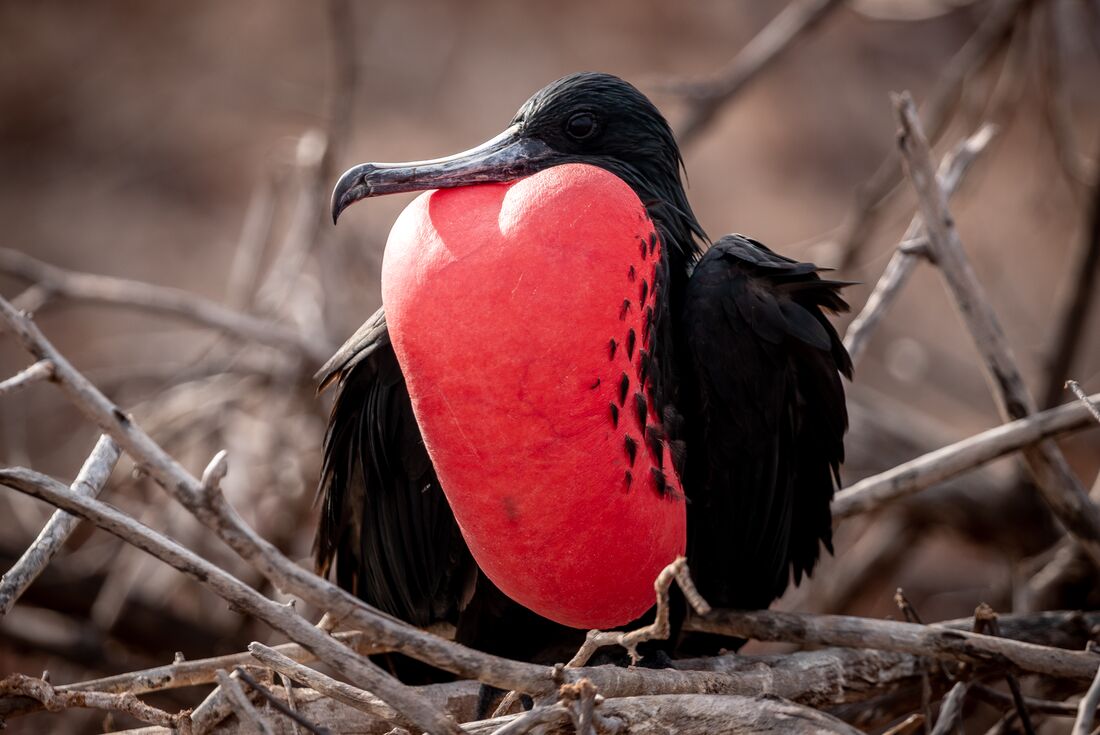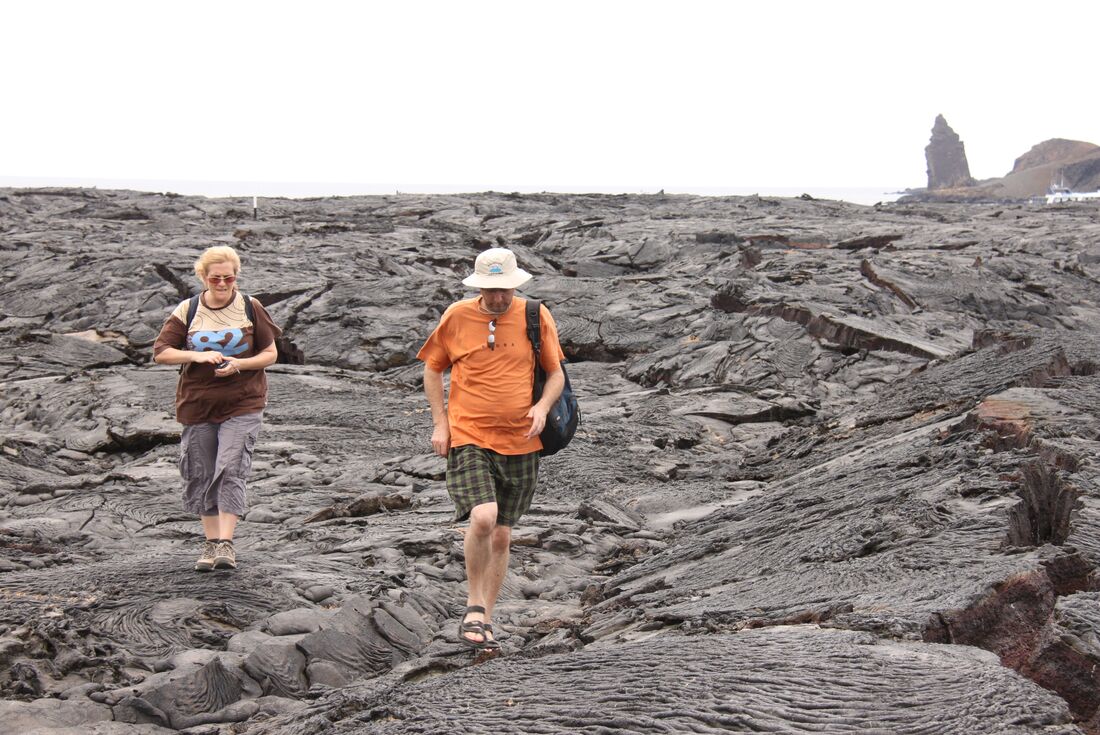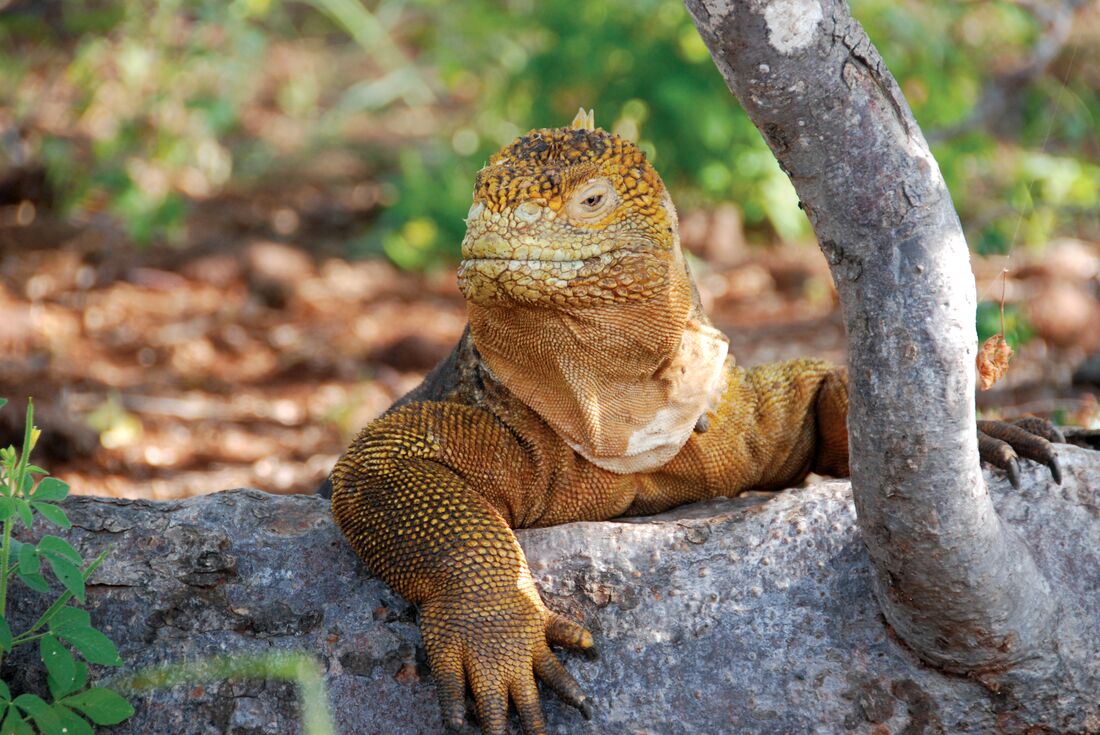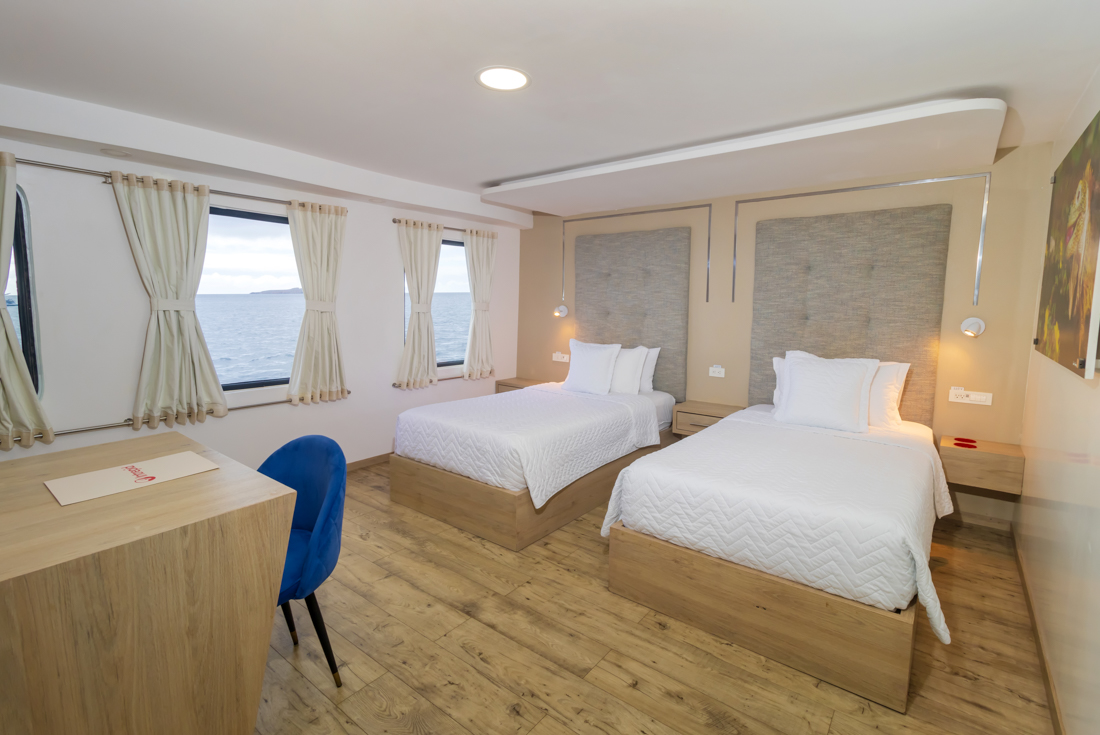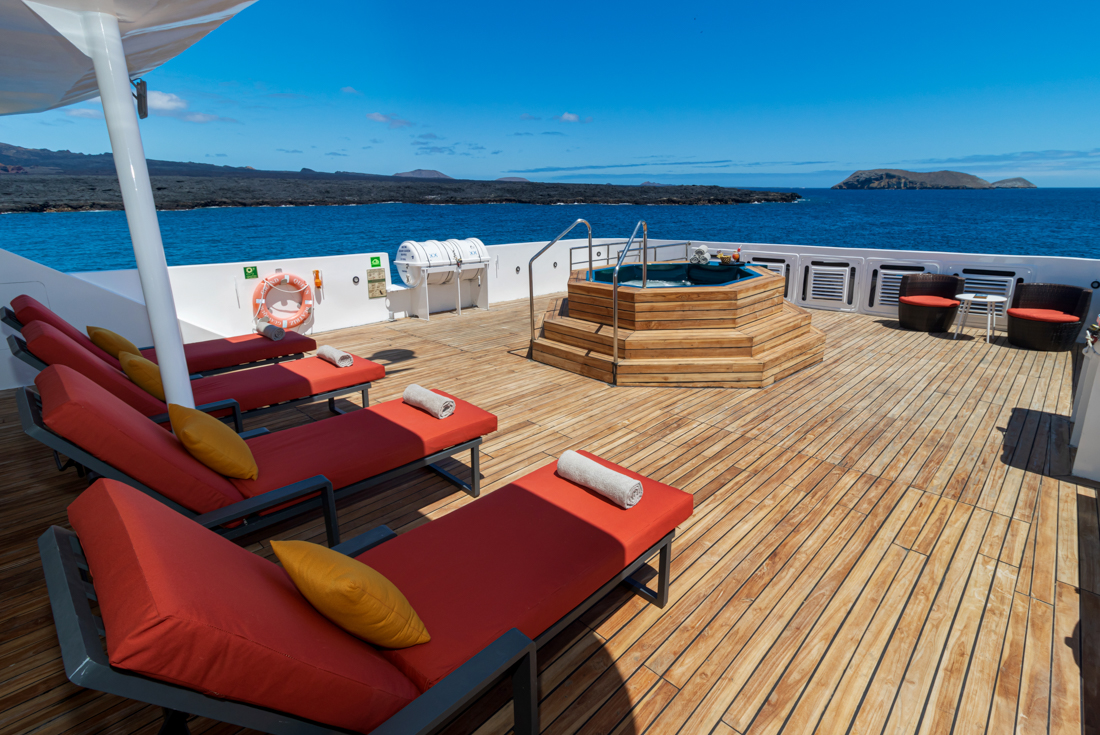SUMMARY
Climb aboard the stylish Grand Queen Beatriz and experience a superb spread of Ecuador’s famous wildlife-filled islands. As well as visiting the must-see icons of the archipelago – such as Isla San Cristobal’s frigate birds, Isla Santa Cruz’ giant tortoises, Pinnacle Rock and Isla Bartolome’s Pinnacle Rock – this 13-day itinerary covers key central islands. Among them are North Seymour, with its beautiful trails and birdlife, and Isla Rabida, with its indigenous wildlife and striking scarlet shores. With volcanic landscapes, sea turtles, marine iguanas, spectacular sea birds and possibly even hammerhead sharks on the agenda, this is an essential Galapagos adventure for animal lovers, keen snorkellers and photographers alike.
TOTAL DURATION : 14 Days
GROUP SIZE : MIN 1 MAX 16
TOUR ITINERARY AND DATES
START : Quito
END : Quito
COUNTRIES VISITED : Ecuador
Validity : 01 JAN 2022 To 31 DEC 2024
Day :1
Location : Quito
Welcome to Quito! On arrival at Mariscal Sucre International Airport, you will be met and transferred to your hotel. The remainder of the day will be at your leisure until a welcome meeting this evening. The meeting will be held at either 5 pm or 6 pm, please check with hotel reception or the reception notice board for the exact time and location. After your welcome meeting, head out with your local leader and fellow travellers for a welcome dinner at a local restaurant. Try some traditional flavours and get to know you group as you settle into the coming adventure. Quito sits at high altitude under the towering Pichincha volcano. It is a beautiful city, arguably one of the most beautiful in South America, and there is plenty to occupy you should you arrive with time to spare. The Old Town, for example, has many museums and churches to explore, including the ornate La Compania de Jesus.
Day :2
Location : Isla Baltra - Isla Santa Cruz
This morning you will be transferred to the airport for your flight to the Galapagos Islands. Please note the pick-up time will usually be as early as 4:30 am (a boxed breakfast will be provided), as the airport is a one-hour drive away and you must allow for delays and check-in times. (Your tour leader will confirm this time with you at the Welcome Meeting on Day 1). A US$20 per person transit card is payable on departure at Quito Airport and a US$100 per person national park entry fee is payable on arrival on the islands. Please have cash on hand for these transactions as credit cards are not accepted. The flight to the Galapagos will make one stop in Guayaquil to pick up other passengers. (Total flight time is about 3.5 hours). On arrival in the Galapagos, you will be met in the arrival hall of the airport (look out for 'Grand Queen Beatriz' signs) by a transfer guide and transferred to our motor yacht - ‘M.Y. Grand Queen Beatriz’, anchored on the other side of Isla Santa Cruz. Our transfer guide will take you on an airport public bus for a short distance (5 minute drive) to where you board a public ferry across the Itabaca Channel. The ferry crossing takes only 7 minutes. (Please note that all public transportation costs are included). Once you reach Isla Santa Cruz, you board a private bus for a 45-minute drive to Puerto Ayora, the main port of the island. Here, there will be two dinghies to transport you and your fellow travellers to the 'M.Y. Grand Queen Beatriz'. Once on board, cabins will be assigned and there will be a welcome briefing and safety drill. You will then get to meet our crew members and get to know your naturalist guide while enjoying a delicious lunch. After lunch, head up into the highlands for a total change of scenery. Beginning at the coast you'll travel across Santa Cruz through the agricultural region and into the misty forests, with the walk taking about 45 minutes. This is a lush humid zone containing miconia bushes, scalesia and inactive volcanic cones. Santa Cruz has more endemic plants than any of the other islands, and you are likely to see Galapagos giant tortoises in their natural habitat and perhaps even the bright red feathers of a vermillion flycatcher! Estimated travel time/distance: Puerto Ayora to Isla Santa Fe: 2 hours (16 nautical miles)
Day :3
Location : Isla Santa Fe - Isla Plaza Sur
Isla Santa Fe is home to many sea lions and these ones are very eager for swimming partners! It’s a lovely place to take a dip, offers a dense concentration of wildlife, and is a fantastic place to see many of the stars of the Galapagos in one relatively small area. Expect to see Galapagos hawks, land iguanas, a variety of finches, Galapagos mockingbirds, sea lions, marine turtles, frigatebirds, Galapagos doves and lava lizards. It’s a naturally beautiful island as well with one of the most attractive coves in the archipelago and the jade-green waters are ideal for snorkelling. A trail follows the coast into the opuntia forest, where you see Santa Fe's trees - the largest in the Galapagos. The island is also home to a unique sub-species of land iguanas. Hiking towards the cliffs on Santa Fe will lead you to a forest of prickly pear cactus. A member of the cactus family, their name comes from the pear-shaped fruit the plant produces. Santa Fe is home to endemic land iguanas. A small island, Plaza Sur is nonetheless a place of great beauty, where you will get close to sea lions and on to trails past one of the Galapagos’ largest land iguana populations, resting amid cacti and volcanic landscapes coloured bright red and green by sesuvium. The island’s rugged southern cliffs are an excellent place to spot tropicbirds and swallow-tailed gulls, as well as the 'Gentlemen’s Club’, a gathering of male sea lions either too young or too old to be beachmasters! Estimated travel time/distance: Isla Santa Fe to Isla Plaza sur: 2 hours (16 nautical miles) Isla Plaza Sur to Isla Espanola (Punta Suarez): 7 hours (60 nautical miles)
Day :4
Location : Isla Espanola - Bahia Gardner - Punta Suarez
After an overnight night sail you will wake up on the island of Española - the southernmost island of the Galapagos and one of the most spectacular. Because of its remote location, this island has a large population of endemic fauna. It is the breeding site for nearly all of the world's 12,000 pairs of waved albatrosses and also home to colonies of blue-footed and masked boobies. Trails from the golden beaches, where sea lions bathe and marine iguanas make their way towards the water, will lead you right through the middle of booby colonies, and Galapagos doves and mockingbirds are also often seen. You will also visit the beautiful white sandy beaches at Bahia Gardner, which are great places for swimming and relaxing. The rocks off the coast provide excellent snorkelling opportunities, with reef sharks, turtles and many species of tropical fish, including surgeon and angelfish, often seen. The small white-tipped reef sharks are also often spotted resting under the rocks. You will also pay a visit to Punta Suarez, one of the most attractive locations in the Galapagos and home to large and varied wildlife population - a walk along its trails will take you to a cliff top viewpoint, where you'll gain a magical panorama. Boobies line the rocky shoreline beneath you, while frigate birds may be seen overhead; nearby enormous male sea lions can be seen lounging and albatross use the cliffs as their ‘runway’, helping become airborne by the southeast winds that blow across this part of the island. If you’re lucky you’ll see the elaborate courtship rituals performed by albatrosses before the female chooses her lifelong mate! Stop at Bahia Gardner (Gardner Bay), which is considered by many as one of the most beautiful beaches in the Galapagos Islands and full of sea lions and hood mockingbirds. Enjoy the beach and do some snorkelling which could be great for playing with sea lion pups and lots of fish. The rocks off the coast provide excellent snorkelling opportunities, with reef sharks, turtles and many species of tropical fish, including surgeon and angelfish, often seen. The small white-tipped reef sharks are also often spotted resting under the rocks. Estimated travel time/distance: Punta Suarez to Bahia Gardener: 1 hour (7 nautical miles) Bahia Gardener to Punta Pitt (Isla San Cristobal): 7 hours (50 nautical miles)
Day :5
Location : Isla Cristobal - Leon Dormido - Isla Lobos - Punta Pitt
This morning you will visit Punta Pitt on the eastern end of Isla San Cristobal. Walk to the top of the volcanic hill for expansive views of the sparsely vegetated area. A variety of seabirds nest here, including blue-footed boobies and frigates. You will then navigate close by Leon Dormido (Kicker Rock) the basalt remains of a crater in the middle of the sea, with the shape resembling a sleeping lion. The rock rises 150 meters above the surface and is divided into two parts by a narrow channel. Although there are no landing areas, you will circumnavigation the Rock where you will see tropic birds, marine iguanas in the water and many sea lions. You will also visit Isla Lobos, a tiny island almost touching San Cristobal. This is the perfect time to see the always friendly sea lions as they play in the calm shallow waters here. There are also blue-footed boobies, frigate birds and marine iguanas around the island. Estimated travel time/distance: Punta Pitt to Kicker Rock (Isla San Cristobal): 2.5 hours (27 nautical miles) Kicker Rock to Isla Lobos: 1 hour (7 nautical miles) Isla Lobos to Puerto Baquerizo (Isla San Cristobal): 1 hour (5 nautical miles)
Day :6
Location : Isla San Cristobal - Interpretation Center & Highlands
This afternoon you will travel into the interior of the island to visit the highlands site of ‘Galapaguera of Cerro Colorado’ (Red Hill) where the national park has established a breeding program and information centre for tortoises. Here, we will be able to see giant tortoises in their natural habitat and learn all about their origin, evolution and their threatened future. Estimated travel time/distance: Puerto Baquerizo (Isla San Cristobal) to Bartolome: 8 hours (70 nautical miles)
Day :7
Location : Bartolome - Bahia Sullivan
Bartolome is one of the most spectacular volcanic landscapes in the Galapagos, full of parasitic spatter cones, lava flows, Galapagos penguins and lava lizards. It is a relatively new island in the archipelago and traces of its volcanic past can be seen everywhere, as evidenced by the amazing lunar-like landscape. The Pinnacle Rock is one of the most photographed sites in the Galapagos – an abrupt jag of rock protruding from the earth like a tooth, while nearby two golden bays back onto each other. You can hike to the top of a once-active volcano here (360 wooden steps), and enjoy superb views across to Sullivan Bay, on nearby Santiago Island. If you are in luck you might catch a glance of the Galapagos Hawk here. You also have the opportunity to go snorkelling with plenty of tropical fish, starfish, white-tipped reef sharks, rays and hopefully penguins. On Santiago's eastern coast sits Bahia Sullivan, also known as James Island. Here you walk on Pahoe-Hoe lava, from an eruption that occurred in 1897, and witness the colonisation of plant species since the last eruption. Hopefully see some marine iguanas, Sally Lightfoot crabs, sea lions, finches, turtles, sharks and penguins. On a walk, your guide will explain the geological history of the islands. Estimated travel time/distance: Bartolome to Isla Santiago: 0.5 hours (1 nautical mile) Isla Santiago to Espumilla Beach: 3 hours (25 nautical miles)
Day :8
Location : Isla Santiago - Espumilla Beach - Buccaneer Cove - Puerto Egas
Today you will visit some wonderful places. Espumilla Beach, on the northern coast of Santiago Island in James Bay, is one of the most idyllic locations in the Galapagos Islands and is an important nesting site for marine turtles. With large waves, it is also often a favourite amongst beach lovers. Potentially we will see Galapagos hawks up close, ghost crabs, blue-footed boobies (often plunging for fish) and brown pelicans. It is also well known for its palo santo forest and some extraordinary lava formations. You will also visit Caleta Bucanero (Buccaneer Cove), a natural monument of rocks caused by sea erosion. This cove was used by pirates to careen their ships. It is a place of local legends and stories! It is also where Darwin camped for nine days while making his study of the islands and their wildlife. If conditions are favourable, you can enjoy some further snorkelling. Puerto Egas is a black sand beach located on the west side of James Bay and northwest of Santiago Island. South of the beach is Sugarloaf Volcano, which has deposits of volcanic tuff. This site is named Puerto Egas, after Hector Egas who last attempted to mine salt here. The walk along the beach offers hundreds of marine iguanas and Galapagos sea lions. You will also see amazing tidal pools formed from ancient lava flow and home to sponges, snails, hermit crabs, barnacles and fish. Snorkelling with the seals always offers the possibility of thrilling encounters. Estimated travel time/distance: Espumilla Beach to Bucaneer Cove: 0.5 hours (1 nautical mile) Bucaneer Cove to Puerto Egas: 0.5 hours (1 nautical mile) Puerto Egas to Puerto Ayora: 7 hours (60 nautical miles)
Day :9
Location : Isla Santa Cruz
Today you will visit Santa Cruz, the second largest island in the Galapagos. The small town of Puerto Ayora is the economic centre of the archipelago, and home to the Charles Darwin Research Station. As well as undertaking vital conservation work, the station also makes for interesting exploration and offers the best opportunities for close encounters with giant tortoises. You will also observe baby tortoises and land iguanas. Afterward you will head up into the highlands for a total change of scenery. Beginning at the coast you'll travel across Santa Cruz through the agricultural region and into the misty forests with the journey taking about 45 mins. This is a lush humid zone containing miconia bushes, scalesia and inactive volcanic cones. Santa Cruz has more endemic plants than any of the other islands and you are likely to see Galapagos giant tortoises in their natural habitat and perhaps even the bright red feathers of a vermillion flycatcher! Today there will be some passengers leaving the tour and some new passengers joining. Note: today we visit the Puerto Ayora Highlands again, you have the option to take the afternoon free time to explore the town. Estimated travel time/distance: Puerto Ayora to Santa Fe: 2 hours (16 nautical miles)
Day :10
Location : North Seymour - Isla Mosquera
Today you will take a morning excursion to North Seymour which is one of the most visited islands in the Galapagos. The trail on North Seymour crosses inland through the island and then explores the rocky coast. Along the way the trail passes colonies of blue footed boobies and frigate birds. The magnificent frigate bird, a large black bird with a long wingspan, and a hooked beak, is extremely fast and has excellent vision. Frigate birds are known for the large red pouch on their necks. During mating season the males throw back their heads, inflate the pouch (sometimes to the size of a soccer ball), and shake trying to capture the attention of female frigates. Boobies and frigates have an interesting relationship. Sharing the same nesting area on North Seymour, blue-footed boobies nest on the ground making their nests from the twigs of the palo santos trees, while the frigate birds nests just above them in the saltbushes. Your walk is followed by snorkelling where you will find a great variety of fish and possibly white-tipped reef sharks, rays and sea lions. After lunch you will visit the small sandy island of Mosquera, a relaxing, picturesque stop situated between Baltra and North Seymour. Along the rocks and in the tide pool, Sally Lightfoot crabs (red lava crabs) scamper back and forth, skipping across small pools of water in search of food. These crabs with their bright red shell tops and blue under shells are stunning against the black lava. The island also has a very large colony of sea lions as well as a sizeable resident brown pelican population. Depending on the tides and visibility, you may have a chance to go snorkelling here. Estimated travel time/distance: North Seymour to Isla Baltra: 4 hours (35 nautical miles) Isla Baltra to Caleta Tortuga: 1 hour (7 nautical miles)
Day :11
Location : Black Turtle Cove - Cerro Dragon
Today you will take a morning excursion on a 'panga' to Caleta Tortuga Negra (Black Turtle Cove) - a red mangrove wetland on the north shore of Isla Santa Cruz. You will paddle among the cove’s peaceful waters, for your first taste of the underwater riches of this region – it’s a wonderful place to see green turtle and is a nursery for golden cow-nose rays, eagle rays and Galapagos sharks. There is also abundant birdlife, such as the yellow warbler and lava heron. This is also a breeding area for turtles, so it is not uncommon to see them mating. In the afternoon, cruise over for a walk on Cerro Dragon (Dragon Hill) this afternoon - one of the best places to see land iguanas in the islands. From our dry landing we walk to a brackish lagoon frequented by lagoon birds including stilts, pintail ducks, sandpipers, sanderlings and occasionally flamingos. Further inland, the trail offers a beautiful view of the bay and the western area of the archipelago. This area is a nesting site for land iguanas, which is constantly monitored and assisted by the Charles Darwin Research Station. The arid-zone vegetation makes for a rewarding location for birdwatching with Darwin's finches, Galapagos mockingbirds, the endemic Galapagos flycatcher and yellow warblers all regulars here. The path can be challenging but you will be well-rewarded with a spectacular view of the bay! Estimated travel time/distance: Caleta Tortuga Negra to Cerro Dragon: 2 hours (12 nautical miles) Cerro Dragon to Sombrero Chino: 1.5 hours (9 nautical miles)
Day :12
Location : Isla Rabida - Sombrero Chino
Sombrero Chino is a small islet located near the south-east coast of Santiago. It's shaped like a Chinese hat (Sombrero Chino) when seen from afar, and is geologically fascinating, with many lava tubes leading from the cone to the coast. We approach Sombrero Chino via a beautiful crescent-shaped, sandy beach that is home to sea lions and Sally Lightfoot crabs. Opposite Sombrero Chino, on the rocky shoreline of nearby Santiago, Galapagos penguins are often seen. We follow a trail that circles the cove and passes through a sea lion colony and innumerable marine iguanas. The cove also offers some great snorkelling opportunities, hopefully with penguins and sharks. Isla Rabida, also known as Jervis Island, is a tiny island sitting roughly five kilometres south of Santiago and is one of the most striking of the archipelago. Introduced species were eradicated in 1971, meaning that the indigenous wildlife has now been returned to a state of splendid isolation. Additionally, volcanic activity here has produced vivid, fantastical colours, not least the beaches of red sand and cliffs of scarlet. From the shore, the trail leads through to what is one of the finest lagoons in the Galapagos for viewing flamingos. Rabida is also a wonderful place to spot nesting pelicans. Elsewhere, pintail ducks, marine iguanas and sea lions are all present. There is an opportunity for snorkelling in a place where sea stars, damsels, gobbies and surgeon fish are numerous. Estimated travel time/distance: Sombrero Chino to Isla Rabida: 1 hour (7 nautical miles) Isla Rabida to Bachas Beach: 1 hour (7 nautical miles)
Day :13
Location : Las Bachas - Isla Baltra - Quito
As flights to the mainland from Galapagos depart mid morning, it is an early start for our last morning on the islands. Depending on the time of our flight, our time spent on this final excursion could be limited. As you will be leaving the boat this morning, please remember that if you have enjoyed the services provided by your guide and crew, a tip would be very much appreciated by them. As a guideline we recommend each passenger consider US$15 per day for the crew and US$10 per day for your guide. You can leave tips in envelopes that are placed in your cabin on the last day of your journey. Today you will take an early morning excursion to Las Bachas, which was so named after the barges abandoned by the American Navy here in the 1940s. The sandy, white beaches of Las Bachas on the north shore of Santa Cruz Island are a nesting site for the Pacific green turtle, and marine iguanas are also commonly seen. The sand here is particularly white and soft as it is made of decomposed coral. The rocks provide great snorkelling and are the perfect habitat for the Sally Lightfoot crabs, which are plentiful on the island. A saltwater lagoon near the beach is home to flamingo and whimbrel, and look out too for great blue herons. This is your final excursion before you return to the airport in Baltra for your flight back to Quito. The flight will stopover in Guayaquil to drop off/pick up new passengers. Upon arrival in Quito Airport (approx. 4pm) you will be transferred back to your hotel for an overnight stay. Our local representative may stop by at your hotel this evening to get your feedback on your Galapagos experience. Estimated travel times/distance: Queen Beatriz to Isla Baltra: 15 mins Flight time Isla Baltra to Quito: approx 3.5 hours (including transit in Guayaquil) Transfer Quito Airport to Hotel: 1 hour (depending on traffic)
Day :14
Location : Quito
Your Galapagos adventure will come to an end today after breakfast. There are no activities planned for the final day so you are able to depart the accommodation at any time. There are many fascinating things to do in and around Quito, so please speak to our customer service representative about any optional activities that might be of interest. They can also assist you in booking a departure transfer to the airport.
Reference : IT




